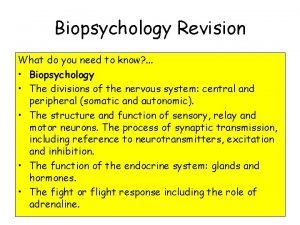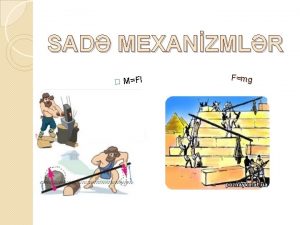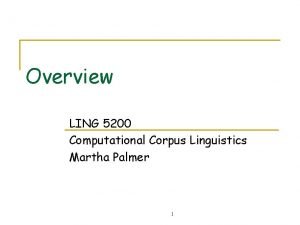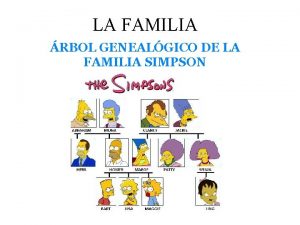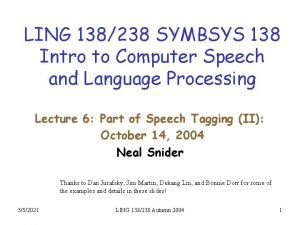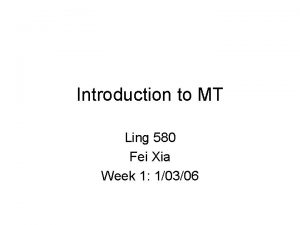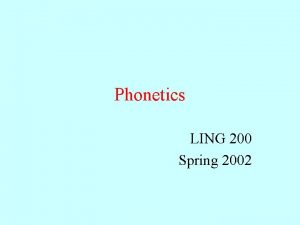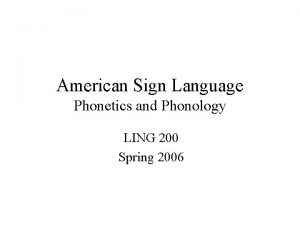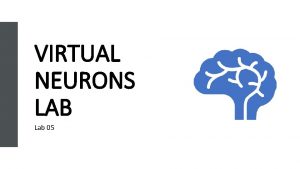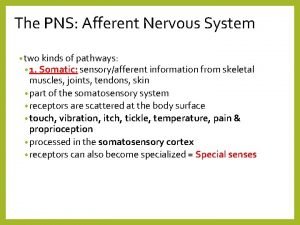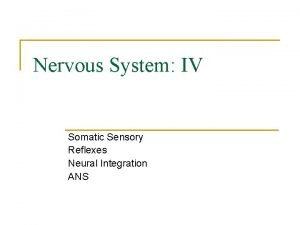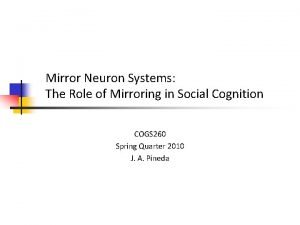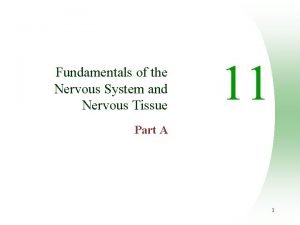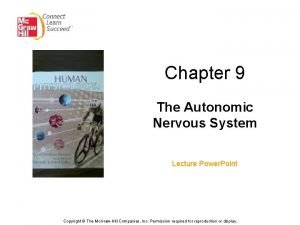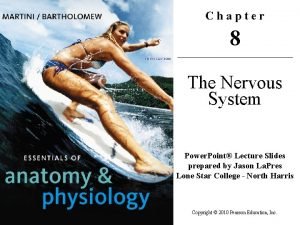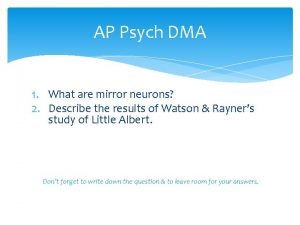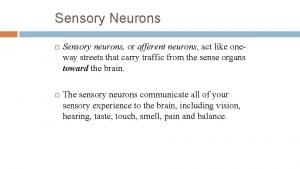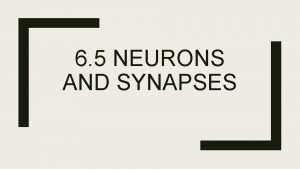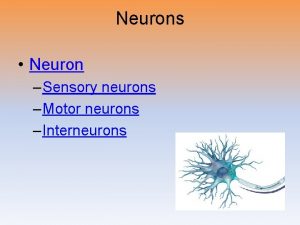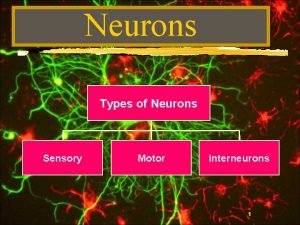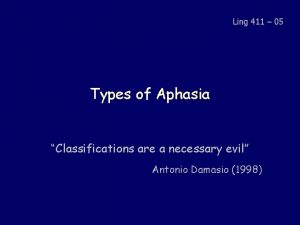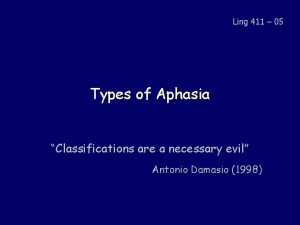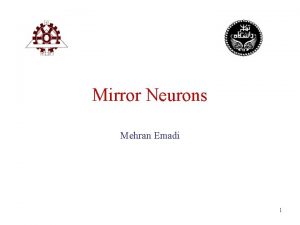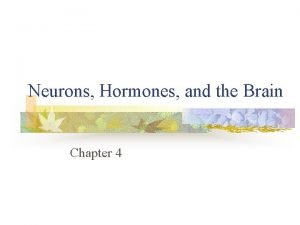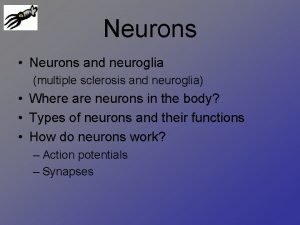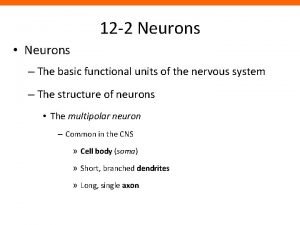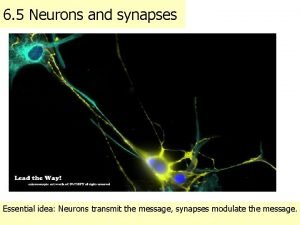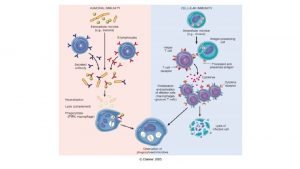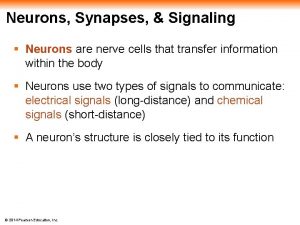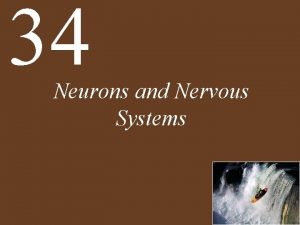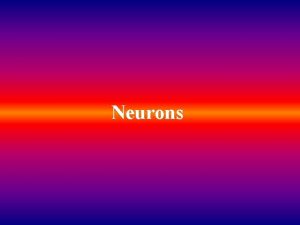Ling 411 02 Introduction to Neurons Types Structure






















































- Slides: 54

Ling 411 – 02 Introduction to Neurons Types, Structure, Operation Cortical Columns

Coronal Section Gray matter White matter

Schematic of coronal section

Coronal section Gray matter White matter Sylvian fissure Insula

Some brain quantities § The cortex accounts for 60 -65% of the volume of the brain • But has only a minority of the total neurons of the brain • That is, about 400 sq inches • • Range: 1, 130 – 1, 610 grams Average: 1, 370 grams • Female brain grows faster than male during 1 st 4 yrs • • Range: 1. 4 – 4. 0 mm Average: 2. 87 mm § Surface of the cortex – about 2600 sq cm § Weight of cortex – § Brain mass nears adult size by age six yrs § Thickness of cortex – (inf. from Mountcastle 1998)

The brain operates by means of connections § Neurons do not store information § Rather they operate by emitting activation • To other neurons to which they connect • § Via synapses Proportionate to activation being received § From other neurons via synapses § Therefore, a neuron does what it does by virtue of its connections to other neurons • The first big secret to understanding how the brain operates

Therefore, the linguistic system operates by means of connections § A person’s linguistic system is largely represented in his/her cerebral cortex § The cerebral cortex is a neural network § A linguistic system is therefore represented as a neural network § Therefore, any component of the system does what it does by virtue of its connections to other components • The first big secret to understanding how the linguistic system operates

Cortical Neurons § Cells, but quite different from other cells • Multiple fibers, branching in tree-like • structures § Input fibers: Dendrites § Output fibers: Axons Great variation in length of fibers § Short ones — less than one millimeter § Long ones — several centimeters • Only the pyramidal cells have such long ones

Communicating with other cells § Method one: • Fibers projecting from cell body § Branching into multiple fibers § Input fibers – dendrites • Allow cell to receive from multiple sources § Output fiber – axon • Allows cell to send to multiple destinations § Method two: • Circulation § Circulatory system • Endocrine system § Lymphatic system

Some quantities relating to neurons § Number of neurons • In cortex: ca. 27 billion (Mountcastle) • Beneath 1 sq mm of cortical surface: 113, 000 § Synapses • 440 million synaptic terminals/mm 3 in visual • area Each neuron receives avg 3, 400 synaptic terminals

Formation of neurons in the fetus § 500, 000 neurons are formed per minute in the developing fetus (from a program on PBS, 2002) § By 24 weeks, the brain has most of its neurons § Checking: • 500, 000 per minute • 30 million per hour • 720 million per day • 5 billion per week • 96 billion in 24 weeks • Checks!

Brains of the young and very young § At about 7 months, a child can recognize most sound distinctions of the world’s languages § By 11 months the child recognizes only those of the language of its environment § At 20 months the left hemisphere is favored for most newly acquired linguistic information § Brain mass nears adult size by age six yrs • Female brain grows faster than male during 1 st 4 yrs

Neuronal fibers § Estimated average 10 cm of fibers per neuron • A conservative estimate • Times 27 billion neurons in cortex • Amounts to 2. 7 billion meters of neural fibers in • cortex (27 billion times 10 cm) Or 2. 7 million kilometers – about 1. 68 million miles § Enough to encircle the world 68 times § Enough to go to the moon 7 times Big lesson: Connectivity rules!

Types of cortical neurons § Cells with excitatory output connections • Pyramidal cells (about 70% of all cortical • neurons) Spiny stellate cells § Cells with inhibitory output connections • Large basket cells (two subtypes) • Columnar basket cells • Double bouquet cells • Chandelier cells • Other

Types of cortical neurons Neuron types

Pyramidal neurons Microelectronic probe About 70% of cortical neurons are of this type

Structure of pyramidal neuron Apical dendrite Cell body Myelin Axon

Synapses § The connections between neurons • Neurotransmitters cross from pre-synaptic • terminal to post-synaptic terminal Synaptic cleft – about 20 nanometers § 40, 000 synapses per neuron (4 x 104) • And 27 billion neurons • § i. e. , 27, 000, 000 = 27 x 109 1. 1 x 1015 (over 1 quadrillion) synapses per cortex (4 x 104 x 2. 7 x 1010 = 11 x 1014) (Big lesson: Connectivity rules!)

Diagram of synaptic structure

Release of neurotransmitter Presynaptic terminal releases neurotransmitter

Seven steps of neurotransmitter action

Connections to other neurons § Excitatory • Pyramidal cells and spiny stellate cells • Output terminals are on dendrites or cell bodies • of other neurons Neurotransmitter: Glutamate § Inhibitory • All other cortical neurons • Output terminals are on cell bodies or axons of • other neurons Neurotransmitter: GABA • GABA: gamma-aminobutyric acid

Inhibitory connections Axosomatic Axoaxonal

More on the pyramidal neuron Dendrites Cell body Axon hillock Myelin

Integration of neural inputs Takes place at the axon hillock Excitatory inputs are summed Inhibitory inputs are subtracted Result of this summation is the amount of incoming activation § Determines how much activation will be transmitted along the axon (and its branches), hence to other neurons § Degree of activation is implemented as frequency of spikes § §

Transmission of activation (sensory neuron) Kandel 28

Spread of activation § Activation moves across links • Physical reality: from neuron to neuron • Abstract model: from node to node § At larger scale, across multiple links • In speech production, • § from meanings to their expression For a listener, § From expression to meaning

Another kind of neurotransmitter Released into interneural space, has global effect – e. g. serotonin, dopamine

Events in short time periods § Duration of one action potential: about 1 ms § Frequency of action potentials: 1– 100 per sec § Rate of transmission of action potential: • 1– 100 mm per ms • Faster for myelinated axons • Faster for thicker axons § Synaptic delay: ½ – 1 ms

Traveling the pathways of the brain § Neuron-to-neuron time in a chain (rough estimate) • Neuron 1 fires @ 100 Hz § Time for activation to reach ends of axon • • • 10 mm @ 10 mm/ms = 1 ms § Time to activate post-synaptic receptor – 1 ms Neuron 2 § Activation reaches firing threshold – 4 ms (? ? ) Hence, overall neuron-to-neuron time – ca. 6 ms § Time required for spoken identification of picture • • • Subject is alert and attentive Instructions: say what animal you see as soon as you see the picture Picture of horse is shown to subject Subject says “horse” This process takes about 600 ms

Three views of the gray matter Different stains show different features

Layers of the Cortex From top to bottom, about 3 mm

The (Mini)Column § Extends thru the six cortical layers • Three to four mm in length • The entire thickness of the cortex is accounted for by the columns § Roughly cylindrical in shape § About 30– 50 m in diameter § If expanded by a factor of 100 • Like a tube with diameter of 1/8 inch and length of one foot § If expanded by a factor of 8, 000 • Like a telephone pole with diameter of 10 inches and length of 80 feet

Cortical Columns A graphic model, not an anatomical diagram From M. van. Landingham, unpublished

Features of the cortical (mini)column § 75 to 110 neurons § 70% of the neurons are pyramidal § The rest include • Other excitatory neurons • Several different kinds of inhibitory neurons § For further information: • Vernon Mountcastle, Perceptual Neuroscience (1998)

Cortical minicolumns: Quantities Diameter of minicolumn: 30 microns Neurons per minicolumn: 75 -110 Minicolumns/mm 2 of cortical surface: 1413 Minicolumns/cm 2 of cortical surface: 141, 300 § Approximate number of minicolumns in Wernicke’s area: 2, 825, 000 § § Estimates based on Mountcastle

More quantities § § Number of neurons in cortex: 27. 4 billion Number of minicolumns: 368 million Neurons per minicolumn: average 75 -80 Neurons beneath 1 mm 2 of surface: 113, 000 Mountcastle 96

Cortical column connectivity § The neurons of a column are mutually interconnected • a whole column is active together • the column acts as a single functional unit § The neurons of a column are connected to: • adjacent columns – inhibitory and excitatory • connections (gray matter connections) distant columns, by means of long distance excitatory connections (the white matter)

Columns and neurons § At the small scale. . • each column is a little network § At a larger scale. . • each column is a node of the cortical network § The cerebral cortex: • Gray matter — columns of neurons • and connections to adjacent columns • White matter: • Long-distance inter-column connections N. B. : The cortex operates by means of connections!

Quotation from Mountcastle My general hypothesis is that the minicolumn is the smallest processing unit of the neocortex. (165) Vernon Mountcastle, Perceptual Neuroscience Harvard University Press, 1998

Long-distance cortico-cortical connections § White matter – • Long-distance inter-column connections § Example: the arcuate fasciculus • A bundle of fibers very important for language § Connects Wernicke’s area to Broca’s area

Arcuate Fasciculus (From: www. rice. edu/langbrain)

Some long-distance fiber bundles (schematic)

Coronal Section Grey matter White matter

Topology of the Gray Matter § Each hemisphere is like a thick napkin, with • Thickness varying from 2 to 4 mm (avg. 3 mm – ca. 1/8 in. ) • Area of about 1300 square centimeters (200 sq. in. ) • Subdivided into six layers § The thickness is accounted for entirely by cortical columns

The White Matter § Provides long-distance connections between cortical columns § Consists of axons of pyramidal neurons § The cell bodies of those neurons are in the gray matter § Each such axon is surrounded by a myelin sheath, which. . • Provides insulation • Enhances conduction of nerve impulses § The white matter is white because that is the color of myelin

Major features of cortical anatomy § Each hemisphere appears to be a threedimensional structure, but. . § Each hemisphere is very thin and very broad § The grooves – sulci – are there because the cortex is “crumpled” so it will fit inside the skull

Topological essence of cortical structure § Two dimensions for the array of the columns § Viewed this way the cortex is an array – a two-dimensional structure – of interconnected columns

Dimensionality of the cortex § Two dimensions: The array of nodes § The third dimension: • The length (depth) of each column (through the six cortical layers) • The cortico-cortical connections (white matter)

Functional layout of the two dimensions § Primary areas: • Visual (occipital) • Auditory (temporal) • Somatosensory (parietal) • Motor (frontal) § Secondary areas § Association areas § Executive area, in prefrontal lobe

Primary and other areas Primary Motor Area Primary Somatosensory Area All other areas are secondary, association, or executive areas Primary Auditory Area Primary Visual Area

Sequence of development in the cortex

Large-scale hierarchy in the cortex § At ‘bottom’, the primary systems • Somatosensory, visual, auditory, motor § In ‘middle layers’ the association areas and ‘higher-level’ motor areas § At ‘top’ (prefrontal cortex) the supra-modal association area • Frontal lobe comprises 1/3 of the area of the • • cortex Prefrontal cortex is nearly 1/4 of the whole cortex Prefrontal functions § Planning, anticipation, mental rehearsal, prediction, judgment, problem solving

end
 Biopsychology revision
Biopsychology revision Jin ling cigarettes
Jin ling cigarettes Bliklar
Bliklar Ling
Ling Erin ling
Erin ling Ling oa
Ling oa Mei-ling from singapore was preparing
Mei-ling from singapore was preparing Como se llama la familia simpson
Como se llama la familia simpson Dr ng li ling
Dr ng li ling Nien-ling wacker
Nien-ling wacker Supperprof
Supperprof Ling simpson
Ling simpson Graph4ai
Graph4ai Who specialized in military gymnastics
Who specialized in military gymnastics Walter ling
Walter ling Ling
Ling Ling138
Ling138 Ling
Ling Mt ling
Mt ling Wai ling lam
Wai ling lam Ling oa
Ling oa Wang ling relationship
Wang ling relationship Huo lingyu
Huo lingyu Ling rolled
Ling rolled Sinus of venae cavae
Sinus of venae cavae Language
Language Cheung yin ling
Cheung yin ling Magic lam
Magic lam Tree in lung tissue
Tree in lung tissue Ling term goals
Ling term goals Mei-ling huang
Mei-ling huang Ling 200
Ling 200 Ling internet
Ling internet Agnes ling
Agnes ling Ling 100
Ling 100 Ida ling
Ida ling Ling 200
Ling 200 Virtual neurons
Virtual neurons First second and third order neurons
First second and third order neurons Homunculus
Homunculus 1st order 2nd order 3rd order neurons
1st order 2nd order 3rd order neurons Divergence neurons
Divergence neurons Input neurons
Input neurons Somatic motor pathways
Somatic motor pathways Inverse stretch reflex
Inverse stretch reflex Location of sensory neurons
Location of sensory neurons Mirror neuron
Mirror neuron Input neurons
Input neurons Identify each type of neuronal pool
Identify each type of neuronal pool Corticospinal tract pathway
Corticospinal tract pathway Fourth order neurons
Fourth order neurons Cranial vii
Cranial vii Adrenergic receptors sympathetic or parasympathetic
Adrenergic receptors sympathetic or parasympathetic Figure 8-2 neurons and neuroglia
Figure 8-2 neurons and neuroglia Mirror neurons ap psych
Mirror neurons ap psych
